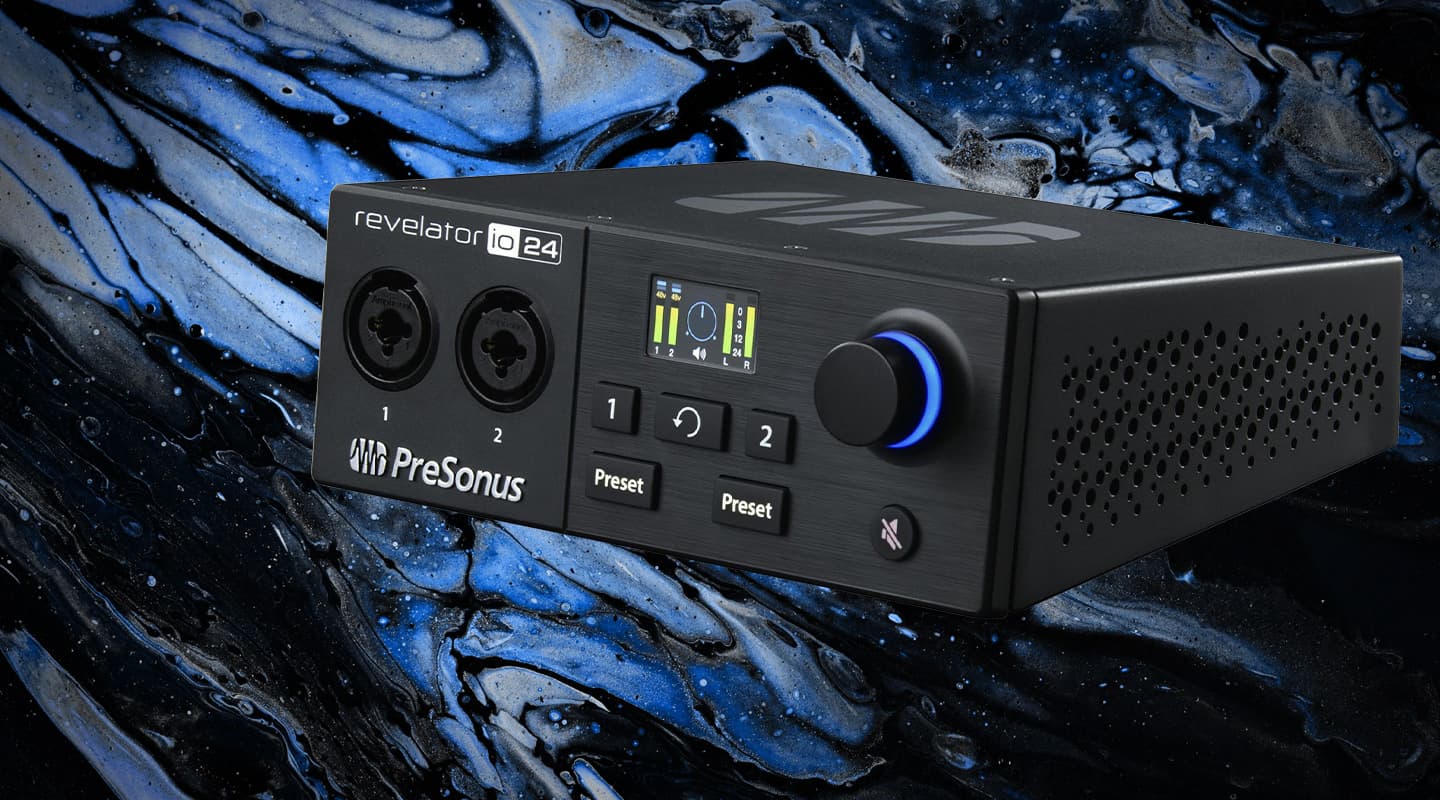
Review: PreSonus Revelator io24
A ‘first of its kind’ interface from PreSonus – will it prove to be revelatory for online content creators?
You’d be forgiven if, at first glance, you didn’t think PreSonus’s new audio interface screams ‘innovation’. The Revelator io24 looks mostly the same as any other budget bus-powered USB interface. Connectivity credentials are modest, with two analogue mic/line/instrument inputs, a headphone output, a pair of monitor outs, and MIDI I/O.
But PreSonus is touting the Revelator io24 as a ‘first of its kind’ because it’s designed with a very specific focus on podcasting and live streaming.
You may ask, what distinguishes a podcasting or live streaming interface from any other two-input box?
The difference lies underneath the unassuming exterior.
SCRATCHING THE SURFACE
Most recording interfaces will come with routing software to control the interface and create custom mixes for real-time headphone monitoring or sending audio out and in through physical I/O. The focus of Revelator io24’s software control extends beyond getting audio in and out of the interface to ferrying audio streams internally between different applications.
Built-in DSP is another distinguishing feature, although not uncommon among interfaces nowadays. By way of a DSP chip, PreSonus has loaded Revelator io24 with the same Fat Channel processing found in StudioLive consoles – and it significantly opens up the unit’s breadth of functionality.
LOOPING BACK
With the rise of live streaming, podcasting and Twitching, you can understand why loopback inputs are necessary to turn audio from a video call or game or browser into a recordable, routable input.
If you’ve ever tried to record an application like Zoom, iTunes or a video game to a DAW, you’ll know it’s not as simple as it seems. The internal routing structures of most interfaces will have any audio originating from within your computer headed in the direction of a physical output like your monitors or headphones. To be able to record this signal means turning it around and back into the interface’s routing matrix as an input. This is called a loopback input.
Loopback inputs aren’t anything new, but on a small interface they’re rarely more than a mere stereo channel. Revelator io24’s loopback functionality is central to the product’s MO. Loopback routing is handled by the DSP chip, not the driver, meaning it costs nothing to your CPU and it’ll work exactly the same across Mac and PC systems. More on that soon, but first let’s take a tour of the device itself.
NEED TO KNOW
ON THE OUTSIDE
Front panel control on the Revelator io24 is elegant and functional. Having a built-in colour screen and rotary push-knob is a luxury on an interface of this size. The blue glow around the dial lends it a smart aesthetic while the backlit rubber buttons are great for dimly lit studios. Pressing the dial on the home screen cycles its function through Monitor volume, Headphone volume, and Input/Output Mix. I must admit the multi-function knob concept often results in me constantly changing settings for the wrong thing – like wondering why the mic meter is still clipping when the level is decreasing in my headphones only to realise I’m turning down headphone level and not preamp gain. Just make a habit of checking the screen for the knob’s current function before tweaking it.
The two X-MAX preamps supply a clean 60dB of gain. Push buttons 1 or 2 to select the respective physical input where you can wind up the gain and engage phantom power or a 80Hz high-pass filter.
UNIVERSAL CONTROL
On the software side, Revelator io24 is piloted from the Presonus Universal Control application, available for Mac or PC. Importantly, it’s where the Fat Channel processing for both analogue inputs can be manipulated.
I was pleasantly surprised by the breadth of Fat Channel options. Beyond the very usable presets, you can individually control multiple processors – a HPF, gate, compressor, EQ, limiter and Voice – through a dropdown tray which reveals the plug-in GUIs. A few variants are available for the comp and EQ including FET, Tube, Passive and Vintage emulations. The kid in me had endless fun mangling a vocal mic with the more ridiculous Voice presets… Bots, Pitch Down and Ring Mod, in particular, are a hoot. There’s a modifiable reverb too, with separate Ch1 and Ch2 sends and a Return fader.
Two snapshots of Fat Channel settings can be toggled using the Preset button on the interface. What’s cool is these presets will be retained within the Revelator io24 even without a computer connected, letting you gain up and process mics to take the output straight into, say, a camera, with nothing but the untethered interface (and of course a USB power supply).
Speaking of being untethered, the Revelator io24 can be controlled wirelessly with the UC Surface app for iPad, Windows and Android. Just connect your device to the same network as the computer for mobile manipulation of all mixes and Fat Channel processing.
IN THE MIX
Universal Control lets you create up to four mixes – Main, Record, Loopback 1 and Loopback 2. That’s right: you get two whole mixes dedicated to assignable loopback channel outputs. So not only can you use Revelator io24’s two loopback inputs to accept audio from your computer applications, but you can push curated mixes back into those applications. Click the headphone icon on any of these four mixes to monitor it through the headphone output.
The Main mix goes to the physical monitor outputs on the back of the interface.
The Record mix is greyed out until you click the Stream Mix button at the top of the window. This sends the output of the Record mix back into your computer via USB as a stereo mixdown which appears in a DAW or live streaming software as the ‘Revelator IO 24’ input.
And as mentioned, the other two Loopback mixes create independently routable stereo mixdowns to fling to various internal locations, be it another VC application or live streaming software.
not only can you use Revelator io24’s two loopback inputs to accept audio from your computer applications, but you can push curated mixes back into those applications

TEST CASE
Of course, the best way to understand all of that information is to use the interface in a real world scenario. I put Revelator io24 to the test with a typical scenario for an online content creator: live streaming a video call conversation, with the ability to add background music underneath. I used Google Meet for the video call, iTunes for music, and OBS as the streaming software.
The three audio inputs comprise my microphone coming into a Revelator preamp, the audio from Google Meet, and the music from iTunes. To take individual control of these sources, a bit of careful setup is required. First, I assigned Google Meet’s input and output to Loopback 1. Next, I set the output of iTunes to Loopback 2 (on a Mac, you do this in System Preferences). Then in OBS I set the primary audio source to ‘Revelator IO 24’, which is fed by the Record mix once Stream Mix mode is activated in Universal Control.
Switching over to Universal Control, I went to the Loopback 1 mix (feeding the Google Meet input), turned up my mic channel so the guest could hear me, added a little Loopback 2 level so the caller could hear the music as well, and made sure the Loopback 1 fader was muted to avoid a feedback loop of the caller’s own voice.
Now that the Google Meet feed was set up, next was configuring the recording feed. Clicking the Stream Mix button in Universal Control activates the Record mix and instantly level showed up in OBS. Clicking the headphone icon on the Record mix ensured I was monitoring the same mix that would be streamed. The beauty of this independent control over all inputs is being able to craft the perfect balance of my voice, the guest’s voice and the background music for the live stream.
Ultimately, the benefit is clear: to have so much control in routing audio between applications makes for much more customisable, flexible and professional-sounding podcasts or live streams. The two layers of icing on top are, 1) the ability to record and stream at the same time, and 2) the ability to use Fat Channel to sweeten your analogue inputs.
PACKAGE DEAL
In case you’re DAW-less, Revelator io24 comes with a copy of Studio One Artist which lets you enjoy the tight integration perks of using PreSonus hardware and software. And it really can’t be overstated how great an addition Fat Channel is. It’s what makes the interface supremely capable, even if used only as a recording tool by a bedroom musician.
PreSonus has put a lot of thought into the Revelator io24 to ensure it works for the podcasters and live streamers whose online presence matters. All too often managing multiple streams of live audio within the one computer required workarounds and compromises. Revelator io24 puts you back in control.

























RESPONSES